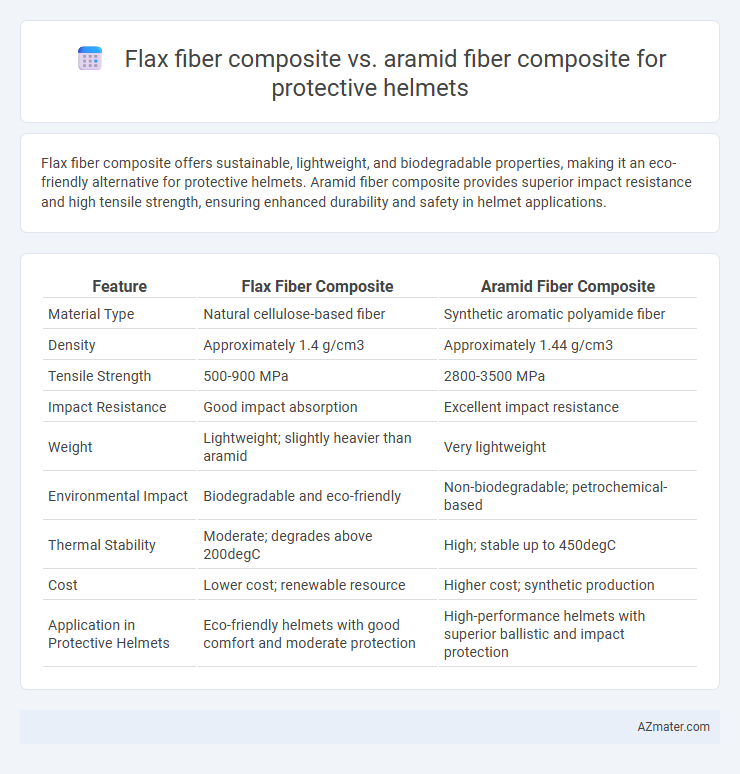Flax fiber composite offers sustainable, lightweight, and biodegradable properties, making it an eco-friendly alternative for protective helmets. Aramid fiber composite provides superior impact resistance and high tensile strength, ensuring enhanced durability and safety in helmet applications.
Table of Comparison
| Feature | Flax Fiber Composite | Aramid Fiber Composite |
|---|---|---|
| Material Type | Natural cellulose-based fiber | Synthetic aromatic polyamide fiber |
| Density | Approximately 1.4 g/cm3 | Approximately 1.44 g/cm3 |
| Tensile Strength | 500-900 MPa | 2800-3500 MPa |
| Impact Resistance | Good impact absorption | Excellent impact resistance |
| Weight | Lightweight; slightly heavier than aramid | Very lightweight |
| Environmental Impact | Biodegradable and eco-friendly | Non-biodegradable; petrochemical-based |
| Thermal Stability | Moderate; degrades above 200degC | High; stable up to 450degC |
| Cost | Lower cost; renewable resource | Higher cost; synthetic production |
| Application in Protective Helmets | Eco-friendly helmets with good comfort and moderate protection | High-performance helmets with superior ballistic and impact protection |
Introduction to Helmet Composite Materials
Flax fiber composites offer sustainable and lightweight alternatives to traditional helmet materials, providing high tensile strength and good impact absorption through natural fiber reinforcement. Aramid fiber composites, known for their exceptional toughness, high tensile strength, and superior energy dissipation, remain the industry standard in ballistic and protective helmets. Both materials balance weight and protection, but flax fibers introduce eco-friendly properties while aramid fibers guarantee established, high-performance safety.
Overview of Flax Fiber Composites
Flax fiber composites offer a sustainable and lightweight alternative to traditional synthetic fibers, making them increasingly popular in protective helmet manufacturing. These composites exhibit excellent mechanical properties, such as high tensile strength and good impact resistance, while providing superior vibration damping compared to aramid fiber composites. Their natural origin also enhances biodegradability and reduces environmental impact without compromising performance in safety applications.
Overview of Aramid Fiber Composites
Aramid fiber composites, such as Kevlar, offer exceptional impact resistance and high tensile strength, making them ideal for protective helmet applications where durability and safety are critical. These composites exhibit superior energy absorption and ballistic protection compared to traditional materials, providing enhanced performance in military and law enforcement helmets. Their lightweight nature combined with thermal stability contributes to improved wearer comfort and extended operational use.
Mechanical Properties Comparison
Flax fiber composites offer high tensile strength and excellent impact resistance, making them a sustainable alternative to traditional materials in protective helmets. Aramid fiber composites, such as Kevlar, exhibit superior tensile strength and higher energy absorption capacity, providing enhanced ballistic resistance and durability. While flax fibers contribute to lightweight and eco-friendly helmet designs, aramid fibers remain the industry standard for maximum mechanical performance and protection.
Impact Resistance and Energy Absorption
Flax fiber composites exhibit superior energy absorption capabilities compared to aramid fiber composites in protective helmets due to their natural fiber microstructure that enhances impact resistance by dissipating energy effectively. Aramid fiber composites, such as Kevlar, provide higher tensile strength and excellent penetration resistance but generally have lower energy absorption capacity under high-impact loading. The combination of flax fiber's bio-based energy dissipation and aramid's strength offers a balanced solution for helmets requiring both impact resistance and crash energy attenuation.
Weight and Comfort Considerations
Flax fiber composites offer a lightweight alternative to aramid fiber composites, significantly reducing the overall weight of protective helmets, which enhances wearer comfort during extended use. The natural fiber structure of flax provides superior breathability and moisture-wicking properties, contributing to increased comfort compared to the synthetic aramid fibers. While aramid fiber composites deliver outstanding impact resistance, flax composites balance protection with improved ergonomics by minimizing fatigue through weight reduction and enhanced ventilation.
Environmental Sustainability and Eco-Friendliness
Flax fiber composites outperform aramid fiber composites in protective helmets by offering significantly lower carbon emissions and enhanced biodegradability, making them a more environmentally sustainable option. Flax fibers, derived from renewable plant sources, reduce dependence on petroleum-based materials found in aramid fibers, which are energy-intensive to produce and difficult to recycle. The use of flax fiber composites supports circular economy principles through easier end-of-life composting and reduced ecological impact in comparison to synthetic aramid alternatives.
Cost Analysis and Manufacturing Complexity
Flax fiber composites offer significant cost advantages over aramid fiber composites due to lower raw material expenses and simpler processing techniques, making them attractive for budget-sensitive protective helmet production. Manufacturing complexity for flax composites is reduced as they require less energy-intensive curing and can be processed using conventional textile methods, whereas aramid fibers demand specialized equipment and stricter handling protocols to maintain fiber integrity. Cost and ease of manufacturing position flax fiber composites as a competitive alternative to aramid composites in the protective helmet industry.
Longevity and Maintenance Requirements
Flax fiber composites exhibit superior biodegradability and environmental resistance, enhancing helmet longevity through natural moisture regulation and reduced material degradation. Aramid fiber composites, such as Kevlar, provide excellent mechanical strength and impact resistance but can suffer from UV degradation and require specialized maintenance to avoid fiber damage. Regular inspections and controlled exposure conditions are critical for maintaining aramid fiber helmets, while flax fiber composites demand minimal maintenance due to inherent durability and resistance to microcracking.
Future Trends in Helmet Composite Innovation
Flax fiber composites demonstrate promising sustainability and impact resistance for protective helmets, offering a lightweight and eco-friendly alternative to traditional aramid fiber composites known for superior tensile strength and thermal stability. Emerging trends emphasize hybrid composites combining flax and aramid fibers to optimize energy absorption and durability while reducing environmental impact. Advances in nanotechnology and resin systems are driving enhanced mechanical performance and improved helmet safety standards, paving the way for next-generation protective gear innovation.

Infographic: Flax fiber composite vs Aramid fiber composite for Protective helmet
 azmater.com
azmater.com